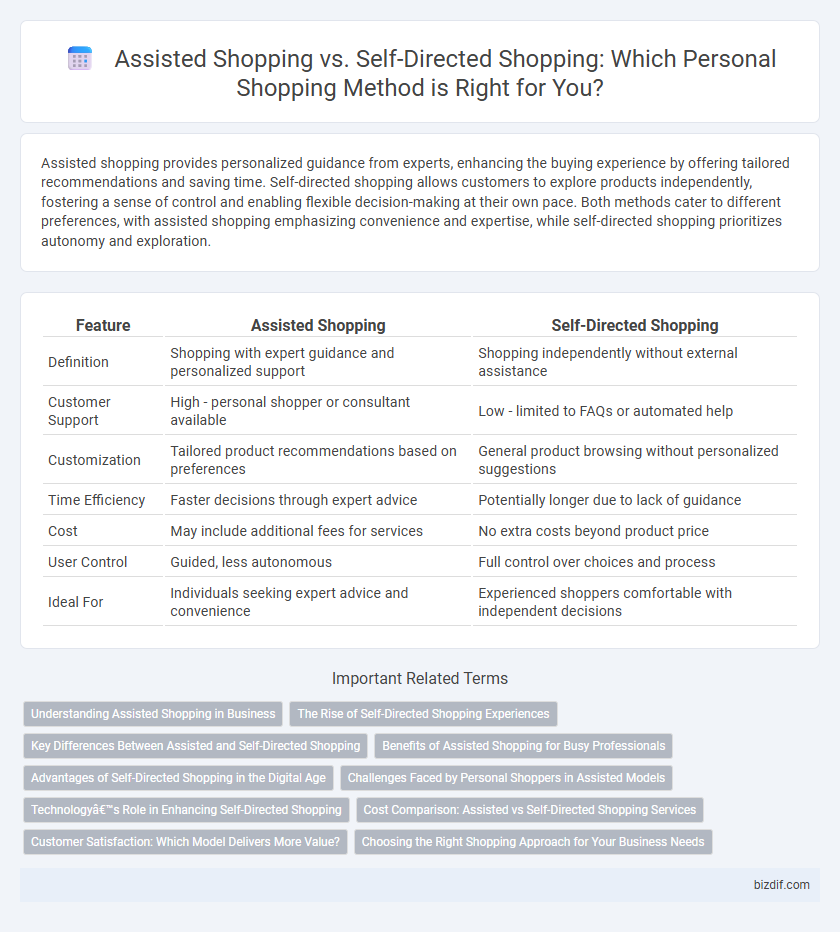Assisted shopping provides personalized guidance from experts, enhancing the buying experience by offering tailored recommendations and saving time. Self-directed shopping allows customers to explore products independently, fostering a sense of control and enabling flexible decision-making at their own pace. Both methods cater to different preferences, with assisted shopping emphasizing convenience and expertise, while self-directed shopping prioritizes autonomy and exploration.
Table of Comparison
| Feature | Assisted Shopping | Self-Directed Shopping |
|---|---|---|
| Definition | Shopping with expert guidance and personalized support | Shopping independently without external assistance |
| Customer Support | High - personal shopper or consultant available | Low - limited to FAQs or automated help |
| Customization | Tailored product recommendations based on preferences | General product browsing without personalized suggestions |
| Time Efficiency | Faster decisions through expert advice | Potentially longer due to lack of guidance |
| Cost | May include additional fees for services | No extra costs beyond product price |
| User Control | Guided, less autonomous | Full control over choices and process |
| Ideal For | Individuals seeking expert advice and convenience | Experienced shoppers comfortable with independent decisions |
Understanding Assisted Shopping in Business
Assisted shopping in business involves personalized support from sales associates or digital assistants who guide customers through product selection, enhancing the shopping experience and increasing conversion rates. Businesses leveraging assisted shopping use data analytics and customer insights to tailor recommendations, improving customer satisfaction and loyalty. This approach contrasts with self-directed shopping, where consumers independently navigate product options, often leading to lower engagement and reduced sales opportunities.
The Rise of Self-Directed Shopping Experiences
Self-directed shopping experiences have surged due to advancements in digital technology, allowing consumers to personalize purchases without direct assistance. Interactive tools, virtual try-ons, and AI-driven recommendations empower shoppers to independently explore options and make informed decisions. This shift enhances convenience and control, catering to growing demand for flexible, on-demand shopping journeys.
Key Differences Between Assisted and Self-Directed Shopping
Assisted shopping offers personalized guidance from sales associates, enhancing customer experience through expert product recommendations and tailored advice. Self-directed shopping empowers consumers to independently explore options, relying on their research and preferences without direct interaction. Key differences include the level of support, decision-making autonomy, and the shopping pace, with assisted shopping prioritizing convenience and self-directed emphasizing control.
Benefits of Assisted Shopping for Busy Professionals
Assisted shopping offers busy professionals personalized recommendations that save valuable time by streamlining product selection based on individual preferences and needs. Expert guidance reduces decision fatigue and increases satisfaction by ensuring high-quality purchases tailored to specific requirements. This service enhances efficiency, allowing professionals to focus on work while receiving curated shopping solutions.
Advantages of Self-Directed Shopping in the Digital Age
Self-directed shopping in the digital age offers unparalleled convenience, allowing consumers to browse and purchase products anytime and anywhere without reliance on assistance. Enhanced by advanced search algorithms and personalized recommendations, this approach empowers shoppers with control over their purchasing decisions and access to extensive product information. Cost savings also arise from the ability to easily compare prices, read reviews, and take advantage of exclusive online deals without the pressure of in-store interactions.
Challenges Faced by Personal Shoppers in Assisted Models
Personal shoppers in assisted shopping models often face challenges such as accurately interpreting client preferences and managing time constraints during in-person appointments. Ensuring real-time inventory availability and coordinating with store staff also complicate the shopping experience. These obstacles demand strong communication skills and efficient resource management to deliver personalized service effectively.
Technology’s Role in Enhancing Self-Directed Shopping
Technology enhances self-directed shopping by offering personalized recommendations through AI algorithms and augmented reality tools that allow virtual try-ons. Mobile apps and seamless payment systems streamline the purchasing process, increasing convenience and efficiency. Interactive product reviews and real-time inventory updates empower shoppers to make informed decisions independently.
Cost Comparison: Assisted vs Self-Directed Shopping Services
Assisted shopping services typically involve higher costs due to personalized support, expert recommendations, and time-saving convenience that justify premium pricing. In contrast, self-directed shopping incurs lower expenses as customers independently browse and select products without additional fees, but may spend more time and risk costly mistakes. Evaluating the cost-efficiency depends on the value placed on expert guidance versus budget-conscious autonomy in the shopping experience.
Customer Satisfaction: Which Model Delivers More Value?
Assisted shopping enhances customer satisfaction by offering personalized guidance, expert recommendations, and real-time support, leading to higher-value purchases and reduced decision fatigue. Self-directed shopping appeals to customers who prioritize autonomy and efficiency, providing flexibility and control over the buying process without pressure. Studies indicate that integrating assisted shopping features into digital platforms significantly increases customer loyalty and perceived value compared to purely self-directed experiences.
Choosing the Right Shopping Approach for Your Business Needs
Assisted shopping enhances customer experience through personalized guidance, expert recommendations, and real-time support, boosting conversion rates and increasing average order value. Self-directed shopping empowers customers with autonomy, streamlined navigation, and efficient search tools, ideal for businesses targeting tech-savvy audiences seeking quick transactions. Selecting the right approach depends on your target market, product complexity, and desired customer interaction level to optimize sales and satisfaction.
Assisted shopping vs Self-directed shopping Infographic

 bizdif.com
bizdif.com